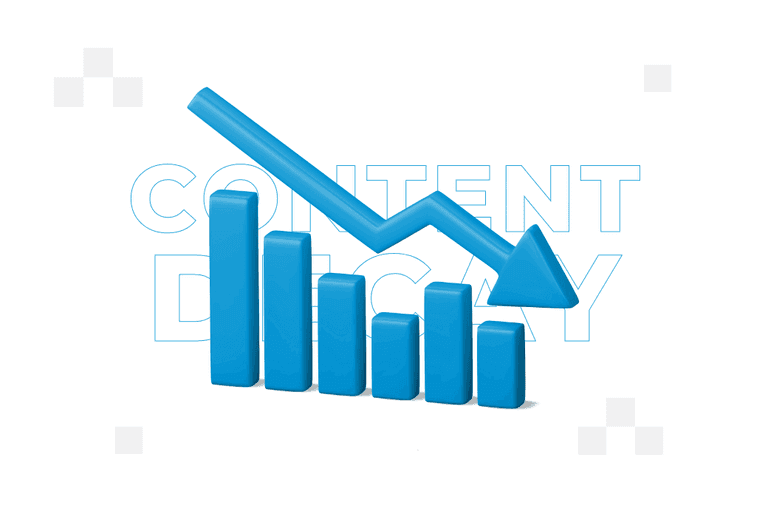
Content decay – what is it and how does it affect SEO?

Creating content that will attract an audience is part of effective marketing. This is why online shops have blogs and personal brands rely on polished communication. If you are also pursuing a marketing strategy and care about high-quality content, then you should be familiar with the concept of content decay.
In this article you will learn:
- What is content decay?
- What are the life stages of content?
- What are the causes of content decay?
- How do you stop content decay?
- How does content decay affect SEO?
Content decay – definition
Content decay is the process of gradual deterioration of the effectiveness of online content that originally generated traffic from organic search results. This is a phenomenon observed in the case of blog articles, category descriptions and other content that lose their visibility in Google search over time. This loss of visibility leads to a reduction in the number of visits, which in turn can reduce the conversion rate.
Content decay is the phenomenon whereby content or pages that were previously popular and generated significant organic traffic gradually lose visibility, traffic and relevance.
Definition of content decay
Importantly, the term decay indicates the gradual nature of the process. It is therefore not a momentary drop in visibility resulting from a sudden algorithm update (e.g. Google’s algorithm), but a slow, gradual decline in the position of a given content in search results. Typically, content decay takes between three and 12 months to occur, although this time can be longer and depends on a number of factors.
Remember that content decay mainly refers to SEO-optimised content that generates organic traffic. It does not apply to content supported by paid advertising campaigns, publications optimised for social media or those that do not perform well in search engines at the start due to a lack of optimisation for specific keywords.
Stages in the lifecycle of content
If you monitor organic traffic and study your site, you will notice that there are four stages of the content life cycle. With these, you can determine when the fade-out phase will occur and act before your texts carry no value for the site. Here are the stages of the content lifecycle:
- Spike Phase – new content has appeared on your site, you see growth and interest in your publication. Traffic is growing at this stage because the search engine has given you a big jump in impressions.
- Growth Phase – the spike in impressions is behind you, so it’s time for a gradual, slow increase in traffic to your site that can only be seen in retrospect. The content remains fairly relevant as there have been many backlinks.
- Plateau Phase – Your content has peaked. This means that it will not become more popular or break through to more phrases. Its position will hold for a few months, for then it will start to decline.
- Decay Phase – this is the stage of content decay. A given subpage becomes less and less popular, its visibility decreases and organic traffic disappears. This is the point at which it should be updated and re-served to the audience.
Causes of content decay
Your content may be slowly losing its position, as well as the interest of your audience, for several reasons. Here are the three main causes:
Outdated content
Google appreciates sites that regularly update their subpages, especially blog articles, articles about legislation or that contain news. The timeliness of content is quite a complex SEO factor, as the algorithms also control how often new content appears on a page. If you are sharing horoscopes with your audience, bear in mind that Google will not offer users content from last year.
Your competitors’ activities
Your competitors are probably betting on content. You are not the only one who cares about results. The more texts come online, the harder it will be to break through with old content. A lot of good blog articles, category descriptions or product descriptions can be created for a month and then positioned for a given phrase.
Search engine updates
Google loves to surprise – especially with new algorithm updates. They have many effects, and these include significant changes in the ranking of the texts in question. Content that was in a high position may suddenly fall below TOP10. So remember to keep an eye on the changes made by Google and adjust your content accordingly.
Stopping content decay
Every website owner wants their website to be popular. Traffic is very important and is often the main indicator measured by businesses. Unfortunately, the results will not be satisfactory if you do not pay attention to content decay and stop it at the right time. How do you do this?
First of all, keep your articles up to date and regularly improve your product descriptions as well as your categories. Systematically work on expanding the text and try to exhaust all information. And in addition:
- adapt the subject matter of your content to your users’ intentions (User Intent),
- improve topical authority,
- control content cannibalisation,
- rely on content pruning,
- turn short-life articles into advice articles,
- analyse your competitors’ content.
Content decay and SEO
The gradual decline in visibility of pages in search results is related to several key aspects of SEO. Firstly, reduced visibility of a page in search results leads to less organic traffic. When content loses its position or user interest, the number of sessions, impressions and overall activity on a page decreases, which affects algorithms as they consider the level of user engagement as an indicator of content quality.
Secondly, Google and other search engines regularly assess content for freshness and value to users. The freshness of the content is significant, so in the decay phase, pages lose not only positions but also interest due to outdated information or lack of new, valuable content.
FAQ
Contact form
Ensure the visibility of your website

Rate content:
You may be interested in:





